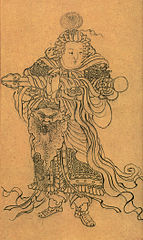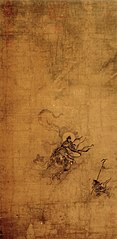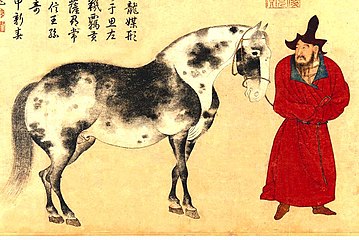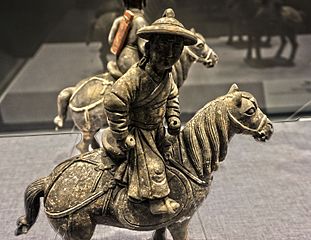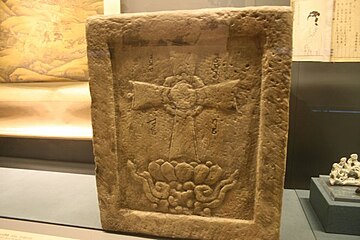Yuan dynasty
Great Yuan
| |||||||||||||||
|---|---|---|---|---|---|---|---|---|---|---|---|---|---|---|---|
| Government | Monarchy | ||||||||||||||
| Emperor[note 3] | |||||||||||||||
• 1260–1294 | Kublai | ||||||||||||||
• 1332–1368 | Toghon Temür | ||||||||||||||
Chancellor | |||||||||||||||
• 1264–1282 | Ahmad Fanakati | ||||||||||||||
• 1340–1355 | Toqto'a | ||||||||||||||
| Historical era | Red Turban Rebellion | 1351–1368 | |||||||||||||
• Fall of Khanbaliq | 14 September 1368 | ||||||||||||||
• Formation of Northern Yuan dynasty | 1368–1388 | ||||||||||||||
| Area | |||||||||||||||
| 1310[9] | 11,000,000 km2 (4,200,000 sq mi) | ||||||||||||||
| Currency | Jiaochao banknotes, Chinese cash | ||||||||||||||
| |||||||||||||||
| History of Mongolia |
|---|
 |
| Part of a series on the |
| History of China |
|---|
The Yuan dynasty (
Although Genghis Khan's enthronement as Khagan in 1206 was described in Chinese as the Han-style title of Emperor [note 3][6] and the Mongol Empire had ruled territories including modern-day northern China for decades, it was not until 1271 that Kublai Khan officially proclaimed the dynasty in the traditional Han style,[13] and the conquest was not complete until 1279 when the Southern Song dynasty was defeated in the Battle of Yamen. His realm was, by this point, isolated from the other Mongol-led khanates and controlled most of modern-day China and its surrounding areas, including modern-day Mongolia.[14] It was the first dynasty founded by a non-Han ethnicity that ruled all of China proper.[15]: 312 [16] In 1368, following the defeat of the Yuan forces by the Ming dynasty, the Genghisid rulers retreated to the Mongolian Plateau and continued to rule until 1635 when they surrendered to the Later Jin dynasty (which later evolved into the Qing dynasty). The rump state is known in historiography as the Northern Yuan dynasty.
After the division of the Mongol Empire, the Yuan dynasty was the khanate ruled by the successors of
Kublai, as a Khagan (Great Khan) of the Mongol Empire from 1260, had claimed supremacy over the other successor Mongol khanates: the Chagatai, the Golden Horde, and the Ilkhanate, before proclaiming as the Emperor of China in 1271. As such, the Yuan was also sometimes referred to as the Empire of the Great Khan. However, while the claim of supremacy by the Yuan emperors was at times recognized by the western khans, their subservience was nominal and each continued its own separate development.[18][19][page needed]
Name
| Yuan dynasty | ||
|---|---|---|
Hanyu Pinyin Dà Yuán Dà Měnggǔ Guó | | |
| Bopomofo | ㄉㄚˋ ㄩㄢˊ ㄉㄚˋ ㄇㄥˇ ㄍㄨˇ ㄍㄨㄛˊ | |
| Wade–Giles | Ta4 Yüan2 Ta4 Meng3-ku3 Kuo2 | |
| Tongyong Pinyin | Dà Yuán Dà Měng-gǔ Guó | |
| IPA | [tâ ɥɛ̌n tâ mə̀ŋ.kù kwǒ] | |
In 1271,
ᠥᠨ
ᠶᠡᠬᠡ
ᠮᠣᠩᠭᠣᠯ
ᠤᠯᠤᠰ (大元大蒙古國; Dai Ön Yeqe Mongɣul Ulus, lit. "Great Yuan – Great Mongol State")[21] or ᠳᠠᠢ ᠦᠨ
ᠺᠡᠮᠡᠺᠦ
ᠶᠡᠬᠡ
ᠮᠣᠩᠭᠣᠯ
ᠤᠯᠤᠰ (Dai Ön qemeqü Yeqe Mongɣol Ulus, lit. "Great Mongol State called Great Yuan").[22]
As per contemporary historiographical norm, "Yuan dynasty" typically refers to the realm with its main capital in Dadu (modern-day Beijing). However, the Han-style dynastic name "Great Yuan" and the claim to Chinese political orthodoxy were meant for the entire Mongol Empire.[8][12] This usage is seen in the writings, including non-Chinese texts, produced during the time of the Yuan dynasty.[12] In spite of this, "Yuan dynasty" is rarely used in the broad sense of the definition by modern scholars due to the division of the Mongol Empire.[citation needed]
The Yuan dynasty is sometimes also called the "Mongol dynasty" by westerners,
History
Background
Many Han Chinese and Khitan defected to the Mongols to fight against the Jin. Two Han Chinese leaders, Shi Tianze, Liu Heima (劉黑馬, aka Liu Ni),[34] and the Khitan Xiao Zhala (蕭札剌) defected and commanded the 3 Tumens in the Mongol army. Liu Heima and Shi Tianze served Ögedei Khan.[35]: 129–130 Liu Heima and Shi Tianxiang led armies against Western Xia for the Mongols.[36]: 175 There were 4 Han Tumens and 3 Khitan Tumens, with each Tumen consisting of 10,000 troops. The three Khitan Generals Shimobeidier (石抹孛迭兒), Tabuyir (塔不已兒), and Zhongxi, the son of Xiaozhaci (蕭札刺之子重喜) commanded the three Khitan Tumens and the four Han Generals Zhang Rou, Yan Shi, Shi Tianze, and Liu Heima commanded the four Han tumens under Ögedei Khan.[37][38]
Möngke Khan commenced a military campaign against the Chinese Song dynasty in southern China.[39] The Mongol force that invaded southern China was far greater than the force they sent to invade the Middle East in 1256.[40] He died in 1259 without a successor.[41] Kublai returned from fighting the Song in 1260 when he learned that his brother, Ariq Böke, was challenging his claim to the throne.[42] Kublai convened a kurultai in Kaiping that elected him Great Khan.[43] A rival kurultai in Mongolia proclaimed Ariq Böke Great Khan, beginning a civil war.[44] Kublai depended on the cooperation of his Chinese subjects to ensure that his army received ample resources. He bolstered his popularity among his subjects by modeling his government on the bureaucracy of traditional Chinese dynasties and adopting the Chinese era name of Zhongtong.[45] Ariq Böke was hampered by inadequate supplies and surrendered in 1264.[46] All of the three western khanates (Golden Horde, Chagatai Khanate and Ilkhanate) became functionally autonomous, and only the Ilkhans truly recognized Kublai as Great Khan.[47][48] Civil strife had permanently divided the Mongol Empire.[49]
Rule of Kublai Khan
Early years
Instability troubled the early years of Kublai Khan's reign. Ögedei's grandson Kaidu refused to submit to Kublai and threatened the western frontier of Kublai's domain.[4][50] The hostile but weakened Song dynasty remained an obstacle in the south.[4] Kublai secured the northeast border in 1259 by installing the hostage prince Wonjong as the ruler of the Kingdom of Goryeo (Korea), making it a Mongol tributary state.[3][4] Kublai betrothed one of his daughters to the prince to solidify the relationship between the two houses.[51] Korean women were sent to the Yuan court as tribute and one concubine became the empress of the Yuan dynasty.[52] Kublai was also threatened by domestic unrest. Li Tan, the son-in-law of a powerful official, instigated a revolt against Mongol rule in 1262. After successfully suppressing the revolt, Kublai curbed the influence of the Han advisers in his court.[53] He feared that his dependence on Chinese officials left him vulnerable to future revolts and defections to the Song.[54]
Kublai's government after 1262 was a compromise between preserving Mongol interests in China and satisfying the demands of his Chinese subjects.
Founding the dynasty
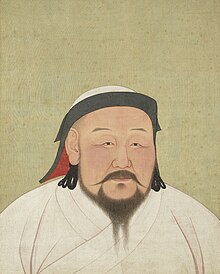
Kublai readied the move of the Mongol capital from
Kublai Khan promoted commercial, scientific, and cultural growth. He supported the merchants of the Silk Road trade network by protecting the Mongol postal system, constructing infrastructure, providing loans that financed trade caravans, and encouraging the circulation of paper jiaochao banknotes. During the beginning of the Yuan dynasty, the Mongols continued issuing coins; however, under Külüg Khan coins were completely replaced by paper money. It was not until the reign of Toghon Temür that the government of the Yuan dynasty would attempt to reintroduce copper coinage for circulation.[66] The Pax Mongolica, Mongol peace, enabled the spread of technologies, commodities, and culture between China and the West.[67] Kublai expanded the Grand Canal from southern China to Daidu in the north.[68] Mongol rule was cosmopolitan under Kublai Khan.[69] He welcomed foreign visitors to his court, such as the Venetian merchant Marco Polo, who wrote the most influential European account of Yuan China.[70] Marco Polo's travels would later inspire many others like Christopher Columbus to chart a passage to the Far East in search of its legendary wealth.[71]
Military conquests and campaigns

 ) appears on all the territory.[72]
) appears on all the territory.[72]After strengthening his government in northern China, Kublai pursued an expansionist policy in line with the tradition of Mongol and Chinese imperialism. He renewed a massive drive against the Song dynasty to the south.
The Duan family still ruled Dali relatively independently during the Yuan dynasty.[76]: 146 The Tusi chieftains and local tribe leaders and kingdoms in Yunnan, Guizhou and Sichuan submitted to Yuan rule and were allowed to keep their titles. The Han Chinese Yang family ruling the Chiefdom of Bozhou which was recognized by the Song dynasty and Tang dynasty also received recognition by the Mongols in the Yuan dynasty and later by the Ming dynasty. The Luo clan in Shuixi led by Ahua were recognized by the Yuan emperors, as they were by the Song emperors when led by Pugui and Tang emperors when led by Apei. They descended from the Three Kingdoms era king Huoji who legendarily helped Zhuge Liang against Meng Huo.[77]: 260 They were also recognized by the Ming dynasty.[78]: 143
In 1276 Kublai captured the Song capital of
The Yuan dynasty created the "Han Army" (漢軍) out of defected Jin troops and an army of defected Song troops called the "Newly Submitted Army" (新附軍).[84]
Kublai's government faced financial difficulties after 1279. Wars and construction projects had drained the Mongol treasury.[85] Efforts to raise and collect tax revenues were plagued by corruption and political scandals.[86] Mishandled military expeditions followed the financial problems.[85] Kublai's second invasion of Japan in 1281 failed because of an inauspicious typhoon.[75] Kublai botched his campaigns against Annam, Champa, and Java,[87] but won a Pyrrhic victory against Burma.[88] The expeditions were hampered by disease, an inhospitable climate, and a tropical terrain unsuitable for the mounted warfare of the Mongols.[87][75] The Trần dynasty which ruled Annam (Đại Việt) defeated the Mongols at the Battle of Bạch Đằng (1288). Annam, Burma, and Champa recognized Mongol hegemony and established tributary relations with the Yuan dynasty.[89]
Internal strife threatened Kublai within his empire. Kublai Khan suppressed rebellions challenging his rule in Tibet and the northeast.[90] His favorite wife died in 1281 and so did his chosen heir in 1285. Kublai grew despondent and retreated from his duties as emperor. He fell ill in 1293, and died on 18 February 1294.[91]
Successors after Kublai
Temür Khan
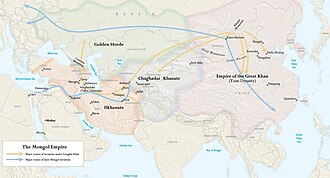
Following the conquest of
Külüg Khan
Külüg Khan (Emperor Wuzong) came to the throne after the death of Temür Khan. Unlike his predecessor, he did not continue Kublai's work, largely rejecting his objectives. Most significantly he introduced a policy called "New Deals", focused on monetary reforms. During his short reign (1307–11), the government fell into financial difficulties, partly due to bad decisions made by Külüg. By the time he died, China was in severe debt and the Yuan court faced popular discontent.[15]: 323
Ayurbarwada Buyantu Khan
The fourth Yuan emperor,
Gegeen Khan and Yesün Temür
Emperor
Before Yesün Temür's reign, China had been relatively free from popular rebellions after the reign of Kublai. Yuan control, however, began to break down in those regions inhabited by ethnic minorities. The occurrence of these revolts and the subsequent suppression aggravated the financial difficulties of the Yuan government. The government had to adopt some measure to increase revenue, such as selling offices, as well as curtailing its spending on some items.[96]
Jayaatu Khan Tugh Temür

When Yesün Temür died in Shangdu in 1328,
Due to the fact that the bureaucracy was dominated by El Temür, Tugh Temür is known for his cultural contribution instead. He adopted many measures honoring
Toghon Temür
After the death of Tugh Temür in 1332 and subsequent death of Rinchinbal (Emperor Ningzong) the same year, the 13-year-old Toghon Temür (Emperor Huizong), the last of the nine successors of Kublai Khan, was summoned back from Guangxi and succeeded to the throne. After El Temür's death, Bayan became as powerful an official as El Temür had been in the beginning of his long reign. As Toghon Temür grew, he came to disapprove of Bayan's autocratic rule. In 1340 he allied himself with Bayan's nephew Toqto'a, who was in discord with Bayan, and banished Bayan by coup. With the dismissal of Bayan, Toqto'a seized the power of the court. His first administration clearly exhibited fresh new spirit. He also gave a few early signs of a new and positive direction in central government. One of his successful projects was to finish the long-stalled official histories of the Liao, Jin, and Song dynasties, which were eventually completed in 1345. Yet, Toqto'a resigned his office with the approval of Toghon Temür, marking the end of his first administration, and he was not called back until 1349.
Decline of the empire


The final years of the Yuan dynasty were marked by struggle, famine, and bitterness among the populace. In time, Kublai Khan's successors lost all influence on other Mongol lands across Asia, while the Mongols beyond the Middle Kingdom saw them as too Chinese. Gradually, they lost influence in China as well. The reigns of the later Yuan emperors were short and marked by intrigues and rivalries. Uninterested in administration, they were separated from both the army and the populace, and China was torn by dissension and unrest. Outlaws ravaged the country without interference from the weakening Yuan armies.
From the late 1340s onwards, people in the countryside suffered from frequent natural disasters such as droughts, floods and the resulting famines, and the government's lack of effective policy led to a loss of popular support. In 1351, the
The
Impact


A rich cultural diversity developed during the Yuan dynasty. The major cultural achievements were the development of
Western musical instruments were introduced to enrich Chinese performing arts. From this period dates the conversion to

Certain Chinese innovations and products, such as purified

Aside from the ancient Roman embassies, the first recorded travels by Europeans to China and back date from this time. The most famous traveler of the period was the Venetian Marco Polo, whose account of his trip to "Cambaluc," the capital of the Great Khan, and of life there astounded the people of Europe. The account of his travels, Il milione (or, The Million, known in English as the Travels of Marco Polo), appeared about the year 1299. Some doubted the accuracy of Marco Polo's accounts due to the lack of mentioning the Great Wall of China, chopsticks, tea houses – which would have been a prominent sight since Europeans had yet to adopt a tea culture – as well the practice of foot binding by the women in capital of the Great Khan. Recent studies however show that Polo's account is largely accurate and unique.[104]
The Yuan undertook extensive public works. Among Kublai Khan's top engineers and scientists was the astronomer
The Yuan dynasty was the first dynasty founded by non-
The dynasty chose white as its imperial color, which corresponds to the Metal element according to the theory of the Five Elements (wuxing). The Metal element does not follow from the Song's dynastic element Five in the creation sequence of the five elements. Instead, it follows from the Jin dynasty's dynastic element Earth. Although the Yuan did not openly announce it, its choice of white as its imperial color suggests that it considered Jin, another conquest dynasty, rather than the Han-Chinese Song dynasty, as its rightful predecessor.[106]
The dragon clothing of Imperial China was used by the
Government

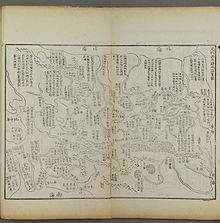
The structure of the Yuan government took shape during the reign of Kublai Khan (1260–1294). While some changes took place such as the functions of certain institutions, the essential components of the government bureaucracy remained intact from the beginning to the end of the dynasty in 1368.
The system of bureaucracy created by Kublai Khan reflected various cultures in the empire, including that of the
While the existence of these central government departments and the Six Ministries (which had been introduced since the
The
Science and technology
Mathematics


Advances in polynomial algebra were made by mathematicians during the Yuan era. The mathematician
Guo Shoujing applied mathematics to the construction of calendars. He was one of the first mathematicians in China to work on spherical trigonometry.[112] Gou derived a cubic interpolation formula for his astronomical calculations.[113] His calendar, the Shoushi Li (授時暦; 'Time Granting Calendar''), was disseminated in 1281 as the official calendar of the Yuan dynasty.[114] The calendar may have been influenced solely by the work of Song dynasty astronomer Shen Kuo or possibly by the work of Arab astronomers.[112] There are no explicit signs of Muslim influences in the Shoushi calendar, but Mongol rulers were known to be interested in Muslim calendars.[114] Mathematical knowledge from the Middle East was introduced to China under the Mongols, and Muslim astronomers brought Arabic numerals to China in the 13th century.[112]
Medicine
The physicians of the Yuan court came from diverse cultures.[115] Healers were divided into non-Mongol physicians called otachi and traditional Mongol shamans. The Mongols characterized otachi doctors by their use of herbal remedies, which was distinguished from the spiritual cures of Mongol shamanism.[115] Physicians received official support from the Yuan government and were given special legal privileges. Kublai created the Imperial Academy of Medicine to manage medical treatises and the education of new doctors.[116] Confucian scholars were attracted to the medical profession because it ensured a high income and medical ethics were compatible with Confucian virtues.[117][116]
The Chinese medical tradition of the Yuan had "Four Great Schools" that the Yuan inherited from the Jin dynasty. All four schools were based on the same intellectual foundation, but advocated different theoretical approaches toward medicine.[117] Under the Mongols, the practice of Chinese medicine spread to other parts of the empire. Chinese physicians were brought along military campaigns by the Mongols as they expanded towards the west. Chinese medical techniques such as acupuncture, moxibustion, pulse diagnosis, and various herbal drugs and elixirs were transmitted westward to the Middle East and the rest of the empire.[118] Several medical advances were made in the Yuan period. The physician Wei Yilin (1277–1347) invented a suspension method for reducing dislocated joints, which he performed using anesthetics.[119] The Mongol physician Hu Sihui described the importance of a healthy diet in a 1330 medical treatise.[119]
Western medicine was also practiced in China by the Nestorian Christians of the Yuan court, where it was sometimes labeled as huihui or Muslim medicine.[120] The Nestorian physician Jesus the Interpreter founded the Office of Western Medicine in 1263 during the reign of Kublai.[121] Huihui doctors staffed at two imperial hospitals were responsible for treating the imperial family and members of the court.[116] Chinese physicians opposed Western medicine because its humoral system contradicted the yin-yang and wuxing philosophy underlying traditional Chinese medicine.[117] No Chinese translation of Western medical works is known, but it is possible that the Chinese had access to Avicenna's The Canon of Medicine.[120]
Printing and publishing

The Mongol rulers patronized the Yuan printing industry.
Private printing businesses also flourished under the Yuan. They published a diverse range of works, and printed educational, literary, medical, religious, and historical texts. The volume of printed materials was vast.[126] In 1312, 1,000 copies of a Buddhist text commented by Cosgi Odsir were printed just within Beijing.[127] By 1328, annual sales of printed calendars and almanacs reached over three million in the Yuan dynasty.[128]
One of the more notable applications of printing technology was the Jiaochao, the paper money of the Yuan. Jiaochao were made from the bark of mulberry trees.[127] The Yuan government used woodblocks to print paper money, but switched to bronze plates in 1275.[129] The Mongols experimented with establishing the Chinese-style paper monetary system in Mongol-controlled territories outside of China. The Yuan minister Bolad was sent to Iran, where he explained Yuan paper money to the Il-khanate court of Gaykhatu.[130] The Il-khanate government issued paper money in 1294, but public distrust of the exotic new currency doomed the experiment.[131]
Foreign observers took note of Yuan printing technology. Marco Polo documented the Yuan printing of paper money and almanac pamphlets called tacuini.
Ceramics
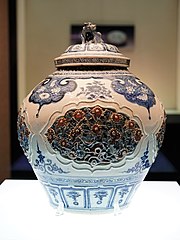
In
Society
Imperial lifestyle
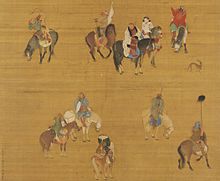
Since its invention in 1269, the
The average Mongol garrison family of the Yuan dynasty seems to have lived a life of decaying rural leisure, with income from the harvests of their Chinese tenants eaten up by costs of equipping and dispatching men for their tours of duty. The Mongols practiced debt slavery, and by 1290 in all parts of the Mongol Empire commoners were selling their children into slavery. Seeing this as damaging to the Mongol nation, Kublai in 1291 forbade the sale abroad of Mongols. Kublai wished to persuade the Chinese that he was becoming increasingly
Religion
There were many religions practiced during the Yuan dynasty, such as
At the same time the Mongols imported Central Asian Muslims to serve as administrators in China, the Mongols also sent Hans and Khitans from China to serve as administrators over the Muslim population in Bukhara in Central Asia, using foreigners to curtail the power of the local peoples of both lands.[135]
Genghis Khan and the following Yuan emperors forbade Islamic practices like Halal butchering, forcing Mongol methods of butchering animals on Muslims, and other restrictive degrees continued. Muslims had to slaughter sheep in secret.
Among all the [subject] alien peoples only the Hui-hui say "we do not eat Mongol food". [Cinggis Qa’an replied:] "By the aid of heaven we have pacified you; you are our slaves. Yet you do not eat our food or drink. How can this be right?" He thereupon made them eat. "If you slaughter sheep, you will be considered guilty of a crime." He issued a regulation to that effect ... [In 1279/1280 under Qubilai] all the Muslims say: "if someone else slaughters [the animal] we do not eat". Because the poor people are upset by this, from now on, Musuluman [Muslim] Huihui and Zhuhu [Jewish] Huihui, no matter who kills [the animal] will eat [it] and must cease slaughtering sheep themselves, and cease the rite of circumcision.[138]
The Muslims in the semu class revolted against the Yuan dynasty in the
During the Ming conquest of Yunnan, Muslim generals Mu Ying and Lan Yu led Muslim troops loyal to the Ming dynasty against Mongol and Muslim troops loyal to the Yuan dynasty.[140][136]: 34
Four-class system
Structure
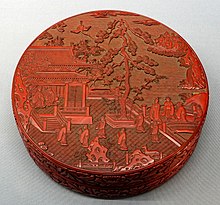

The Mongols had employed foreigners long before the reign of Kublai Khan, the founder of the Yuan dynasty. But during Kublai's reign a hierarchy of reliability was introduced in China. The population was divided into the following classes:[142]
- Chinese script needed] (the citizens of the ruling empire) by the conquered Southern Song population.[143]
- Han, a category usually referring to
- Nan (Southerners), or all subjects of the former Southern Song dynasty, including ethnic Han Chinese and minority native ethnic groups in southern China, as well as the people of the Dali Kingdom. They were sometimes called "Manzi" during the Yuan dynasty. They were on the "bottom of the privilege ladder" in Yuan society.[142]
The ordering of the classes and the placement of people in them came down to how loyal and trustworthy to the Mongols they were. This was defined by the date they surrendered to the Mongols and had little to do with their ethnicity. Ethnic Han Chinese could be classified as either Han ren or Nan ren while Khitans and Jurchens from Qara Khitai were not considered Han but Semu.[144] The earlier they surrendered to the Mongols, the higher they were placed, while the more they held out, the lower they were ranked. As a result, the Northern Chinese were ranked higher than the Southern Chinese, because the Song dynasty in southern China fought longer and surrendered later.[146]: 264–265 [147]: 426 Similarly, the Uighur and Karluk monarchs were ranked higher than the Korean monarch at court because they surrendered earlier while the Koreans surrendered later. The Uighurs in particular were noted to not have fought at all.[145]: 247 [144]
Foreign administrators
The Mongols employed people from different regions to oversee different parts of their empire. Central Asian Muslims served as administrators in China while Han people and Khitans from China served as administrators over the Muslim population in
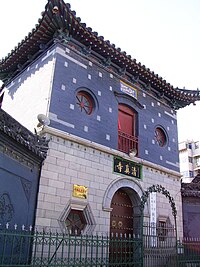
Anti-Chinese policies
Politically, the system of government created by Kublai Khan was the product of a compromise between Mongolian patrimonial
Anti-Semu policies
Despite the high position given to Muslims, some policies of the Yuan emperors severely discriminated against them, restricting Halal slaughter and other Islamic practices like circumcision, as well as
The Muslim merchants in Quanzhou who engaged in maritime trade enriched their families which encompassed their political and trade activities as families. Historians see the violent Chinese backlash that happened at the end of the Yuan dynasty against the wealth of the Muslim and Semu as something inevitable, however anti-Muslim and anti-Semu laws had already been passed by the Yuan dynasty. In 1340 all marriages were forced to follow Confucian principles in marriage regulations, in 1329 all foreign holy men including Muslims had tax exemptions revoked, in 1328 the position of Muslim Qadi was abolished after its powers were limited in 1311. This resulted in anti-Mongol sentiment among Muslims so some anti-Yuan rebels in the mid 14th century were joined by Muslims. In 1357–1367 the Yisibaxi Muslim Persian garrison started a revolt against the Yuan dynasty in Quanzhou and southern Fujian. Persian merchants Amin ud-Din (Amiliding) and Saif ud-Din Saifuding led the revolt. Persian official Yawuna assassinated both Amin ud-Din and Saif ud-Din in 1362 and took control of the Muslim rebel forces. For five years the Muslim rebels tried to strike north and took over some parts of Xinghua but were defeated at Fuzhou two times and failed to take it. Yuan provincial loyalist forces from Fuzhou defeated the Muslim rebels in 1367 after A Muslim rebel officer named Jin Ji defected from Yawuna.[158]: 121 [159]
Criticism
The historian Frederick W. Mote wrote that the usage of the term "social classes" for this system was misleading and that the position of people within the four-class system was not an indication of their actual social power and wealth, but just entailed "degrees of privilege" to which they were entitled institutionally and legally, so a person's standing within the classes was not a guarantee of their standing, since there were rich and well socially standing Chinese while there were less rich Mongol and Semu than there were Mongol and Semu who lived in poverty and were ill-treated.[160]
Japanese historians like Uematsu, Sugiyama and Morita criticized the perception that a four-class system existed under Mongol rule and Funada Yoshiyuki questioned the very existence of the Semu as a class.[161]
Administrative divisions

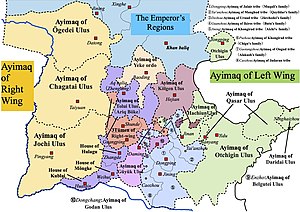
The territory of the Yuan dynasty was divided into the Central Region (腹裏) governed by the Central Secretariat and places under control of various provinces (行省) or Branch Secretariats (行中書省), as well as the region under the Bureau of Buddhist and Tibetan Affairs.
The Central Region, consisting of present-day Hebei, Shandong, Shanxi, the south-eastern part of present-day Inner Mongolia and the Henan areas to the north of the Yellow River, was considered the most important region of the dynasty and directly governed by the Central Secretariat (or Zhongshu Sheng, 中書省) at Khanbaliq (modern Beijing); similarly, another top-level administrative department called the Bureau of Buddhist and Tibetan Affairs (Chinese: 宣政院; pinyin: xuānzhèngyuàn) held administrative rule over the whole of modern-day Tibet and a part of Sichuan, Qinghai and Kashmir.
Branch Secretariats or simply provinces, were provincial-level administrative organizations or institutions, though they were not exactly provinces in modern sense. There were eleven "regular" provinces in Yuan dynasty,[162] and their administrations were subordinated to the Central Secretariat.
Below the level of provinces, the largest political division was the
Basically, lù were higher than fǔ, which were higher than zhōu. However, the actual relationship between them could be very complicated. All of lù, fǔ, and zhōu could administer counties. Some fǔ and zhōu were directly administered by the province, while some existed inside a lù. A lù usually administered several counties, along with several fǔ and zhōu, and the fǔ or zhōu themselves could also administer their own counties. As a result, it is impossible to delineate exactly how many tiers of divisions there were under a province.
This government structure at the provincial level was later inherited and modified by the Ming and Qing dynasties.
Gallery
-
Magic square in Arabic numerals (Yuan dynasty)
-
smelting machines (Yuan dynasty)
-
Water wheel (Yuan dynasty)
-
Water hammer (Yuan dynasty)
-
Weaving machine (Yuan dynasty)
-
water mill gear (Yuan dynasty)
-
loom (Yuan dynasty)
-
Yuan painting (Zhao Mengfu)
-
Chuangzi Nu (Yuan dynasty)[163]
-
Military costume.
-
Yuan painting of a legendary figure riding on a dragon.
-
Yuan cavalry
-
Yuan Mongol soldier
-
Genghis Khan's grandson, Kublai Khan during his youth
-
Mongol rider (Yuan dynasty)
-
Chinese stone inscription of a ), dated to the Yuan dynasty
See also
| History of the Mongols |
|---|
 |
- List of emperors of the Yuan dynasty
- Emperor's family tree
- List of Mongol rulers
- Mughal Empire
- History of Mongolia
- History of China
- Administrative divisions of the Yuan dynasty
- Yuan dynasty in Inner Asia
- Yuan dynasty coinage
- Islam during the Yuan dynasty
- Europeans in Medieval China
- Hua-Yi distinction
- Jun ware
- List of largest empires
- Wu Qiuyan
Notes
- ^ a b The precise status of Goryeo under Mongol rule is unclear. While Goryeo was a vassal of the Yuan dynasty, many scholars, such as Tan Qixiang, regard it as an autonomous state outside the Yuan territory;[2][3][4] others regard it as an integral part of the Yuan territory.
- ^ a b As per modern historiographical norm, the "Yuan dynasty" in this article refers exclusively to the realm based in Dadu (present-day Beijing). However, the Han-style dynastic name "Great Yuan" (大元) as proclaimed by Kublai in 1271, as well as the claim to Chinese political orthodoxy were meant to be applied to the entire Mongol Empire.[8][12] In spite of this, "Yuan dynasty" is rarely used in the broad sense of the definition by modern scholars due to the disintegrated nature of the Mongol Empire.
- ^ a b c d Since the enthronement of Genghis Khan (成吉思皇帝; Chéngjísī huángdì) in Spring 1206.[6] Decades before Kublai Khan announced the dynastic name "Great Yuan" in 1271, the "Great Mongol State" (Yeke Mongγol Ulus) already used the Han-style title of Emperor (Chinese: 皇帝; pinyin: Huángdì) to translate title Khagan (Chinese: 合罕; pinyin: Héhàn, Great Khan) in Mongolian.[7] Although Kublai Khan announced that he inherited the Mongol throne, Toluid Civil War broke out due to opposition from other Mongols.
- Mongolian Cyrillic, Ikh Yuan Üls/Yekhe Yuan Ulus.[11]
References
Citations
- ^ Walter Koh, ed. (2014). "China under Mongol Rule: The Yuan dynasty" (PDF). China Symposium.
- ISBN 978-7-5031-1844-9.
- ^ a b Rossabi 1994, pp. 436–437.
- ^ a b c d Rossabi 1988, p. 77.
- ^ Andrew West, ed. (21 December 2006). "'Phags-pa Script: Description". BabelStone. Retrieved 22 April 2023.
- ^ a b Song Lian (1976) [1370]. "太祖本紀 [Chronicle of Taizu]". 《元史》 [History of Yuan] (in Literary Chinese). Beijing: Zhonghua Shuju.
元年丙寅,帝大會諸王群臣,建九游白纛,即皇帝位於斡難河之源。諸王群臣共上尊號曰成吉思皇帝。"
"In the first year, on the bingyin day, the emperor greatly assembled the many princes and numerous vassals, and erected his nine-tailed white tuğ banner, assuming the position of Emperor of China at the source of the Onon river. And the many princes and numerous vassals together bestowed upon him the reverent title Genghis Huangdi. - S2CID 224535800.
- ^ a b c d e f Kublai Emperor (18 December 1271), 《建國號詔》 [Edict to Establish the Name of the State], 《元典章》[Statutes of Yuan] (in Literary Chinese)
- JSTOR 2600793.
- ^ ISBN 9780190297640.
- ^ "ᠮᠣᠩᠭᠣᠯ ᠤᠨ ᠶᠡᠬᠡ ᠶᠤᠸᠠᠨ ᠤᠯᠤᠰ" (in Mongolian). Монголын түүхийн тайлбар толь. 2016.
- ^ ISBN 978-0-226-56293-3. At p. 45.
- ^ Mote 1994, p. 624.
- ^ ISBN 978-0-8160-4671-3.
- ^ OCLC 898313910.
- ISBN 0-520-01518-5.[page needed]
- ^ Franke, Herbert (1953). "Could the Mongol emperors read and write Chinese?" (PDF). Asia Major. Second series. 3 (1). Academica Sinica: 28–41.
- ISBN 978-0-8122-1766-7.
- ^ Grousset, René (1939). L'empire des steppes: Attila, Gengis-Khan, Tamerlan [The Empire of Steppes] (in French).
- ^ . 《易傳》 [Commentaries on the I Ching] (in Traditional Chinese).
《彖》曰:大哉乾元,萬物資始,乃統天。
- ISBN 9780933070578.
- ^ 陈得芝 (2009). "关于元朝的国号、年代与疆域问题". 北方民族大学学报. 87 (3).
- ISBN 9780470774670.
- JSTOR 43382329.
- JSTOR 2776897.
- ISBN 9789047410812.
- ^ Ebrey 2010, p. 169.
- ^ Ebrey 2010, pp. 169–170.
- ^ Rossabi 1994, p. 415.
- ^ Allsen 1994, p. 392.
- ^ Allsen 1994, p. 394.
- ^ Rossabi 1994, p. 418.
- ^ Rossabi 2012, p. 65.
- ^ Wen Haiqing (溫海清) (2012). "萬戶路"、"千戶州" ——蒙古千戶百戶制度與華北路府州郡體制 ["Ten thousand per lu", "one thousand per zhou"— the Mongol decimal household administrative system and the lu–fu–zhou–jun structure in northern China]. Fudan Academic Journal. No. 4. Archived from the original on 4 March 2016. Retrieved 27 May 2016.
{{cite magazine}}: CS1 maint: unfit URL (link) - ISBN 978-0-7286-0139-0.
- ISBN 1-878986-01-5. Proceedings of the Soviet-American Academic Symposia "Nomads: Masters of the Eurasian Steppe".
- .
- ^ Ke Shaomin (1920). "Volume 146: Biographies #43". New History of Yuan.
- ^ Allsen 1994, p. 410.
- JSTOR 606298.
- ^ Allsen 1994, p. 411.
- ^ Rossabi 1994, p. 422.
- ^ Rossabi 1988, p. 51.
- ^ Rossabi 1988, p. 53.
- ^ Rossabi 1994, p. 423–424.
- ^ Morgan 2007, p. 104.
- ^ Rossabi 1988, p. 62.
- ^ Allsen 1994, p. 413.
- ^ Allsen 2001, p. 24.
- ^ Morgan 2007, p. 105.
- ^ Rossabi 1994, pp. 438.
- JSTOR 23733178.
- ^ Rossabi 1994, p. 426.
- ^ Rossabi 1988, p. 66.
- ^ Rossabi 1994, p. 427.
- ^ a b Rossabi 1988, pp. 70–71.
- ^ Rossabi 2012, p. 70.
- ^ a b Ebrey 2010, p. 172.
- ^ Rossabi 1988, p. 132.
- ^ Mote 1994, p. 616.
- ^ Rossabi 1988, p. 136.
- ^ Mote 1999, p. 461.
- ^ Mote 1999, p. 458.
- ^ a b Mote 1999, p. 616.
- ^ Rossabi 1994, p. 458.
- ]
- ^ Rossabi 2012, p. 72.
- ^ Rossabi 2012, p. 74.
- ^ Rossabi 2012, p. 62.
- ^ Rossabi 1994, p. 463.
- ^ Allsen 2001, p. 61.
- ISBN 978-1-4426-6667-2.
- ^ Rossabi 1994, p. 429.
- ^ Rossabi 2012, p. 77.
- ^ a b c Morgan 2007, p. 107.
- ISBN 978-90-04-28248-3.
- ISBN 978-1-135-79095-0.
- ISBN 978-0-520-23015-6.
- ^ Rossabi 1994, p. 430.
- ^ Morgan 2007, p. 106.
- ISBN 978-90-04-36615-2.
- ^ Rossabi 2012, pp. 77–78.
- ^ Morgan 2007, p. 113.
- ISBN 978-0-8047-1193-7. Retrieved 27 May 2016.
- ^ a b Rossabi 1994, p. 473.
- ^ Rossabi 2012, p. 111.
- ^ a b Rossabi 2012, p. 113.
- ^ Rossabi 1988, p. 218.
- ^ Rossabi 1988, pp. 218–219.
- ^ Rossabi 1988, pp. 487–488.
- ^ Rossabi 1994, p. 488.
- OCLC 975222159.[page needed]
- OCLC 777020257.
- OCLC 779849477.
- ^ OCLC 801440529.
- ^ Hsiao 1994, p. 551.
- ^ Hsiao 1994, p. 550.
- ^ 成吉思汗直系后裔现身河南 巨幅家谱为证 [Genghis Khan's direct descendants still alive in Henan: huge pedigree chart verifies]. 今日安报 (in Chinese). 6 February 2007. Archived from the original on 28 September 2008.
- ^ "Yuan dynasty (1279–1368)". National Museum of Asian Art. Teaching China with the Smithsonian. Archived from the original on 7 May 2023. Retrieved 3 June 2023.
- ^ Guzman 1988, pp. 568–570.
- ^ Allsen 2001, p. 211.
- ISBN 978-1-904832-77-5. Archived from the originalon 10 September 2011.
- ISBN 978-7-5097-8262-0.Sun Hai (孙海); Lin Xinjian (蔺新建) (2006). 中国考古集成: 宋元明清 [Chinese Archaeology Collections: Song, Yuan, Ming, and Qing] (in Chinese). Central States Ancient Books Publishing House. p. 14.
- ISBN 978-90-04-23193-1.
- ^ Marilyn Shea (2007). "Guo Shoujing – 郭守敬". Chinese Astronomy. University of Maine. Archived from the original on 1 December 2008.
- S2CID 147099574.
- S2CID 256889989.
- ^ Joseph 2011, p. 196.
- ^ Dauben 2007, p. 344.
- ^ Dauben 2007, p. 346.
- ^ Ho 1985, p. 101.
- ^ a b c Ho 1985, p. 105.
- ^ Joseph 2011, p. 247.
- ^ a b Allsen 2001, p. 172.
- ^ a b Allsen 2001, p. 142.
- ^ a b c Rossabi 1988, p. 125.
- ^ a b c Allsen 2001, p. 157.
- ^ Lane 2006, pp. 138–139.
- ^ a b Lane 2006, p. 140.
- ^ a b Allsen 2001, p. 151.
- ^ Allsen 2001, p. 155.
- ^ a b c d Allsen 2001, p. 182.
- ^ Wu 1950, p. 460.
- ^ Allsen 2001, pp. 176–177.
- ^ Wu 1950, p. 463.
- ^ Allsen 2001, p. 181.
- ^ a b c Allsen 2001, p. 183.
- ^ a b Allsen 2001, p. 184.
- ^ Allsen 2001, p. 179.
- ^ Allsen 2001, p. 177.
- ^ Allsen 2001, p. 178.
- ^ Mote 1999, p. 471.
- ISBN 9780521243315.
- ISBN 978-92-3-103654-5.
- ^ JSTOR 41930343.
- ^ ISBN 978-0-7007-1026-3.
- ISBN 978-0-8122-4237-9. Retrieved 28 June 2010.
- ^ a b Leslie, Donald Daniel (1998). "The Integration of Religious Minorities in China: The Case of Chinese Muslims" (PDF). The Fifty-ninth George Ernest Morrison Lecture in Ethnology. p. 12. Archived from the original (PDF) on 17 December 2010.
- ^ ISBN 978-0-674-59495-1.
- ISBN 978-981-230-837-5.
- ^ Chow, Chung-wah (7 September 2012). "What to do in Quanzhou: China's forgotten historic port". CNN Travel. Archived from the original on 18 February 2013.
- ^ ISBN 978-1-4331-0275-2.
- ^ Natsagdorj, S., and C. Dalai. 2003. "Yuan gürnii üyeiin Mongol oron." In Mongol Ulsiin Tuukh, vol. 2: XII-XIV Zuunii Dund üy, edited by C. Dalai and T. Ishdorj. Ulaanbaatar: Admon, p. 225
- ^ a b c Haw, Stephen G. (2014). The Semu ren in the Yuan Empire – who were they?. Joint Research Conference of the Institute for Advanced Studies and the Israel Science Foundation. Jerusalem: Academia.edu. Retrieved 27 May 2016.
- ^ ISBN 978-0-520-04562-0.
- ]
- ISBN 9780415093088.
- ISBN 978-0-521-84226-6.
- ^ a b W. Barthold, ed. (1928). Turkestan Down to the Mongol Invasion. E.J.W. Gibb memorial series (2nd ed.). p. 451.
- ^ Bretschneider, Emil (1888). "The Travels of Ch'ang Ch'un to the West, 1220–1223 recorded by his disciple Li Chi Ch'ang". Mediæval Researches from Eastern Asiatic Sources. Barnes & Noble. pp. 37–108.
- ^ 《元史》 [History of Yuan] (in Traditional Chinese).[not specific enough to verify]
- ^ Hsiao 1994, pp. 491–492.
- ^ Morgan 1982, p. 135.
- ^ Morgan 1982, pp. 124–136.
- ISBN 978-1-68417-005-0.
- S2CID 245584164.
- ISSN 1833-8461. Retrieved 27 May 2016.
- ISSN 1860-1812.
- ISBN 978-1-108-64009-1.
- ^ Mote 2003, p. 492.
- ^ Funada Yoshiyuki (6 November 2010). The Image of the Semu People: Mongols, Chinese, and Various Other Peoples under the Mongol Empire. International Roundtable Entitled "The Nature of the Mongol Empire and Its Legacy". Centre for Studies in Asian Cultures and Social Anthropology, Austrian Academy of Sciences, Vienna. Retrieved 27 May 2016.
- ^ Duosang Mongol History, Vol. 1; Zhong-gou Tong-shi; History of Zhong-gou Border Nationalities; The New Yuan-shih[full citation needed]
- ^ Leong Kit Meng, ed. (2006). "Siege Weapons Types in Chinese Warfare". Chinese Siege Warfare. Archived from the original on 2 December 2009.
Sources
- ISBN 978-0-521-24331-5.
- Allsen, Thomas (2001). Culture and Conquest in Mongol Eurasia. Cambridge University Press. ISBN 978-0-521-80335-9.
- 陳學霖, Hok-Lam Chan (1991). ""Ta Chin" (Great Golden): The Origin and Changing Interpretations of the Jurchen State Name". T'oung Pao. Second Series. 77 (4/5): 253–299. S2CID 162236445.
- Dauben, Joseph (2007). "Chinese Mathematics". In Victor Katz (ed.). The Mathematics of Egypt, Mesopotamia, China, India, and Islam: A Sourcebook. Princeton University Press. ISBN 978-0-691-11485-9.
- Ebrey, Patricia Buckley (2010) [1996]. The Cambridge Illustrated History of China (2nd ed.). Cambridge University Press. ISBN 978-0-521-12433-1.
- Guzman, Gregory G. (1988). "Were the Barbarians a Negative or Positive Factor in Ancient and Medieval History?". The Historian. 50 (4): 558–571. .
- Ho, Peng Yoke (1985). Li, Qi and Shu: An Introduction to Science and Civilization in China. Hong Kong University Press. ISBN 978-0-486-41445-4.
- Hsiao, Ch'i-Ch'ing (1994). "Mid-Yuan Politics". In ISBN 978-0-521-24331-5.
- Joseph, George Gheverghese (2011). The Crest of the Peacock: Non-European Roots of Mathematics. Princeton University Press. ISBN 978-0-691-13526-7.
- Lane, George (2006). Daily Life in the Mongol Empire. Greenwood Publishing. ISBN 978-0-313-33226-5.
- Morgan, David (1982). "Who Ran the Mongol Empire?". The Journal of the Royal Asiatic Society of Great Britain and Ireland. 114 (1): 124–136. S2CID 162310870.
- Morgan, David (2007). The Mongols. Wiley-Blackwell. ISBN 978-1-4051-3539-9.
- Robinson, David (2017), "Yuan Dynasty", Oxford Bibliographies, Oxford University Press, ISBN 978-0-19-992008-2
- Rossabi, Morris (1988). Khubilai Khan: His Life and Times. Los Angeles: University of California Press. ISBN 978-0-520-06740-0.
- Rossabi, Morris (1994). "The reign of Khubilai Khan". In ISBN 978-0-521-24331-5.
- Rossabi, Morris (2012). The Mongols: A Very Short Introduction. Oxford University Press. ISBN 978-0-19-984089-2.
- Mote, Frederick W. (1999). Imperial China: 900–1800. Harvard University Press. ISBN 978-0-674-01212-7.
- Mote (1994). "Chinese society under Mongol rule, 1215-1368". In ISBN 978-0-521-24331-5.
- Smith, John Masson Jr. (January–March 1998). "Review: Nomads on Ponies vs. Slaves on Horses". Journal of the American Oriental Society. 118 (1): 54–62. JSTOR 606298.
- Wu, K. T. (1950). "Chinese Printing under Four Alien Dynasties: (916-1368 A. D.)". Harvard Journal of Asiatic Studies. 13 (3/4): 447–523. JSTOR 2718064.
- Zhao, Gang (January 2006). "Reinventing China: Imperial Qing Ideology and the Rise of Modern Chinese National Identity in the Early Twentieth Century". Modern China. 32 (1): 3–30. S2CID 144587815.
Further reading
- Birge, Bettine (1995). "Levirate marriage and the revival of widow chastity in Yüan China". Asia Major. 3rd series. 8 (2): 107–146. JSTOR 41645519.
- Brook, Timothy. The Troubled Empire: China in the Yuan and Ming Dynasties (History of Imperial China) (Harvard UP, 2010). excerpt
- Chan, Hok-lam; de Bary, W.T., eds. (1982). Yuan Thought: Chinese Thought and Religion Under the Mongols. New York: Columbia University Press. ISBN 978-0-231-05324-2.
- Cotterell, Arthur (2007). The Imperial Capitals of China - An Inside View of the Celestial Empire. London, England: Pimlico. ISBN 978-1-84595-009-5.
- Dardess, John (1994). "Shun-ti and the end of Yuan rule in China". In Denis C. Twitchett; Herbert Franke (sinologist); John King Fairbank (eds.). The Cambridge History of China: Volume 6, Alien Regimes and Border States, 710–1368. Cambridge University Press. pp. 561–586. ISBN 978-0-521-24331-5.
- Ebrey, Patricia Buckley (24 November 2009). Chinese Civilization: A Sourcebook (2nd ed.). Simon and Schuster. ISBN 978-1-4391-8839-2.
- Endicott-West, Elizabeth (1986). "Imperial governance in Yüan times". Harvard Journal of Asiatic Studies. 46 (2): 523–549. JSTOR 2719142.
- Endicott-West, Elizabeth (1994). "The Yuan government and society". In Denis C. Twitchett; Herbert Franke (sinologist); John King Fairbank (eds.). The Cambridge History of China: Volume 6, Alien Regimes and Border States, 710–1368. Cambridge University Press. pp. 587–615. ISBN 978-0-521-24331-5.
- Langlois, John D. (1981). China Under Mongol Rule. Princeton: Princeton University Press. ISBN 978-0-691-10110-1.
- Langlois, John D. (1977). "Report on the research conference: The Impact of Mongol Domination on Chinese Civilization". JSTOR 23497251.
- Paludan, Ann (1998). Chronicle of the China Emperors. London, England: Thames & Hudson. ISBN 978-0-500-05090-3.
- Saunders, John Joseph (2001) [1971]. The History of the Mongol Conquests. University of Pennsylvania Press. ISBN 978-0-8122-1766-7.
- Owen, Stephen, "The Yuan and Ming Dynasties," in Stephen Owen, ed. An Anthology of Chinese Literature: Beginnings to 1911. New York: W. W. Norton, 1997. pp. 723 743. (Archive).
- "Directory of Scholars Working in Sung, Liao, Chin and Yüan". 1987. "Directory of Scholars Working in Sung, Liao, Chin and Yüan". Bulletin of Sung and Yüan Studies, no. 19. Society for Song, Yuan, and Conquest Dynasty Studies: 224–54. JSTOR 23497542.

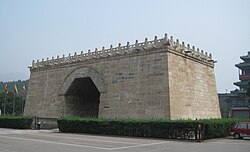



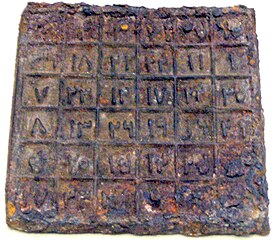
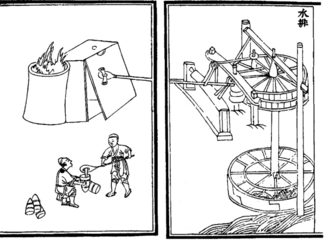
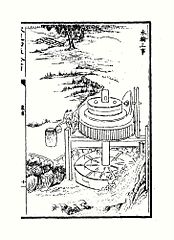
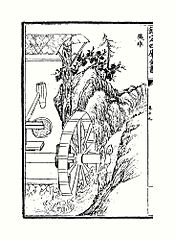
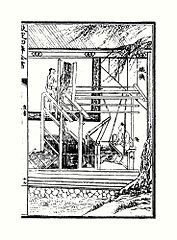

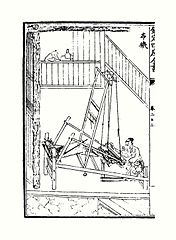

![Chuangzi Nu (Yuan dynasty)[163]](http://upload.wikimedia.org/wikipedia/commons/thumb/8/84/Chuangzi_Nu1.jpg/211px-Chuangzi_Nu1.jpg)
